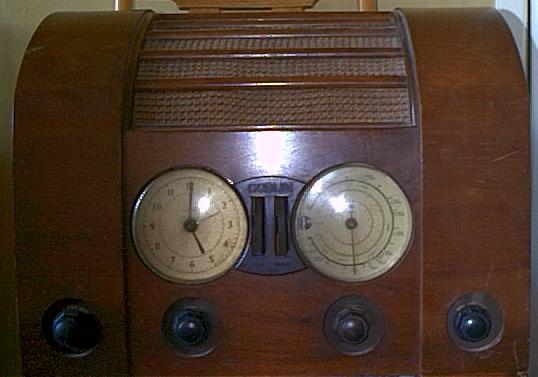|
|
|
The Goblin S25 receiver is quite unique amongst post WWII valve radios, due to the design of the cabinet, and the fact that it is one of the earliest type of clock controlled radios. This set was introduced in 1947, and made by the British Vacuum Cleaner & Engineering Company. However, it was not their only production in radio receivers -there was an export model S26 of this receiver. Later on, in 1950, there was another clock radio, model S30. All these A.C Mains sets employed international octal valves 6K8, 6K7, 6Q7, 6V6, & 5Z4. There were even two Radiograms, model S200 (TYPE A), & S220 (TYPE B) produced by Goblin. With reference to the control knob layout on the S25 (lower, from left to right):- Off / Radio /Auto ; Tone ; Tuning ; Wavechange (medium, short, & long). The two 4" apertures (covered by plastic lenses) are the clock, and the radio dials. The vertical thumbwheel controls are( from left to right):- (a) to set the clock control (smallest hand on the clock) (b) to set the volume control (numbered from one to twelve on a card strip around the volume drum & viewed through an aperture near the tuning dial). The controls for setting the hands (hours & minutes), are by a rod (accessed from the back of the set). The clocks are not very reliable in these sets. The motor winding in my example is open circuit. I managed to get a replacement clock (c/w hands) from another radio collector in Essex. The original clock had only one hand ! The plastic lens and clamp and miniature fitting screws were missing. I had to use some evo-stik adhesive to hold the unsecured part of the lens down to the cabinet (otherwise it would foul up the clock hands). I have installed a new dial cord for the tuning pointer on this set. Both the scale lamps had gone open circuit, so I replaced them (6.5 Volts @ 0.3 Amps m.e.s) I have replaced the Sprague metal capacitors in this set (even though they have been said to be more reliable than the brown wax paper types !). In a recent repair of another radio, I have found some of these Spragues to be "leaky". The last owner of this set added terminal blocks to the end of his mains lead, in order to make an extension mains lead for his set (not a good idea !!). I removed it all, and installed a replacement lead of ample length (plus a 1 Amp fuse in the plug). I still have some more work to do on the energised speaker, and eventually, the clock. --------------------------------------------------------------------------------
Thanks to Aldeburgh tackle shop who donated this fine radio
